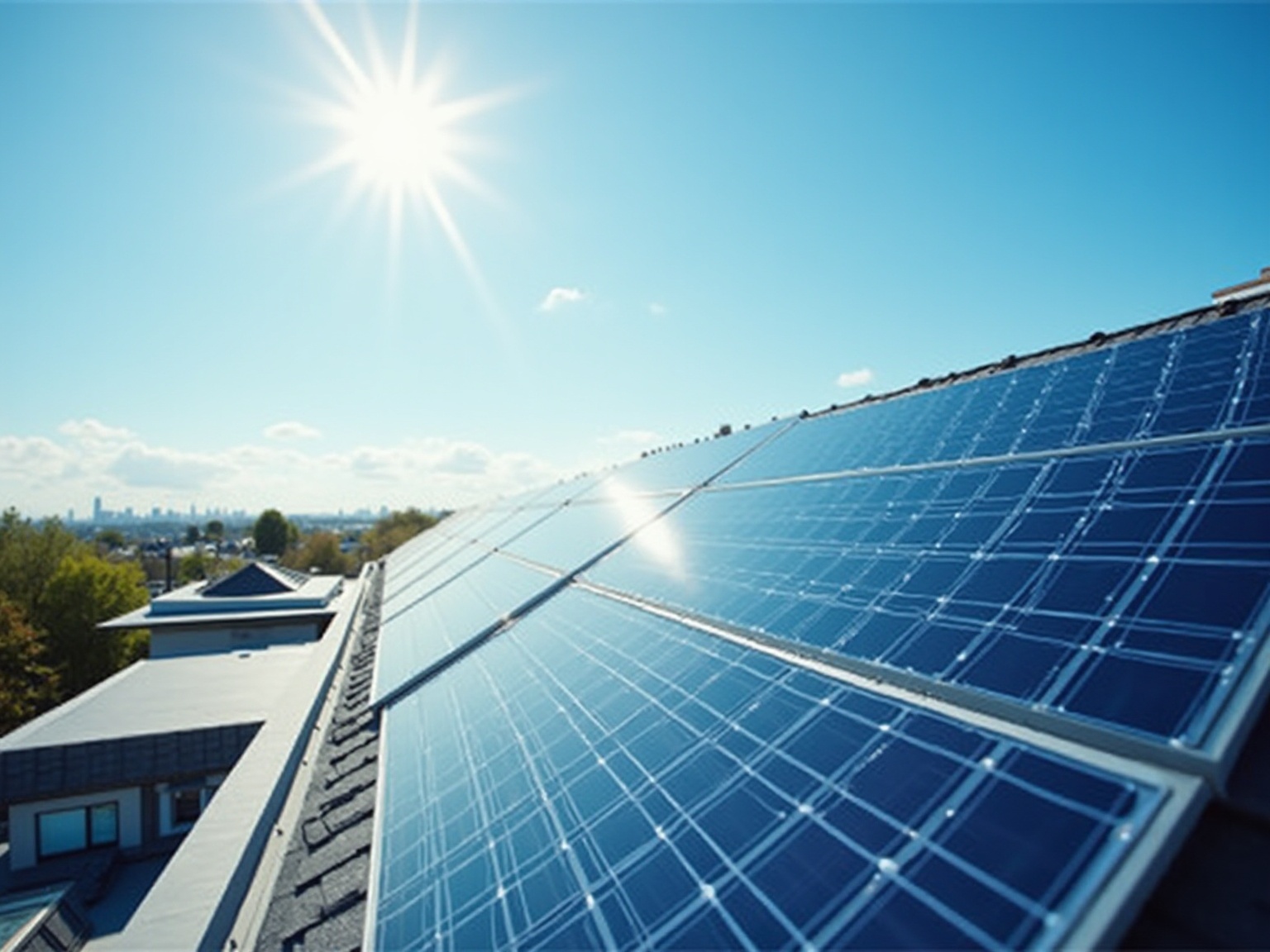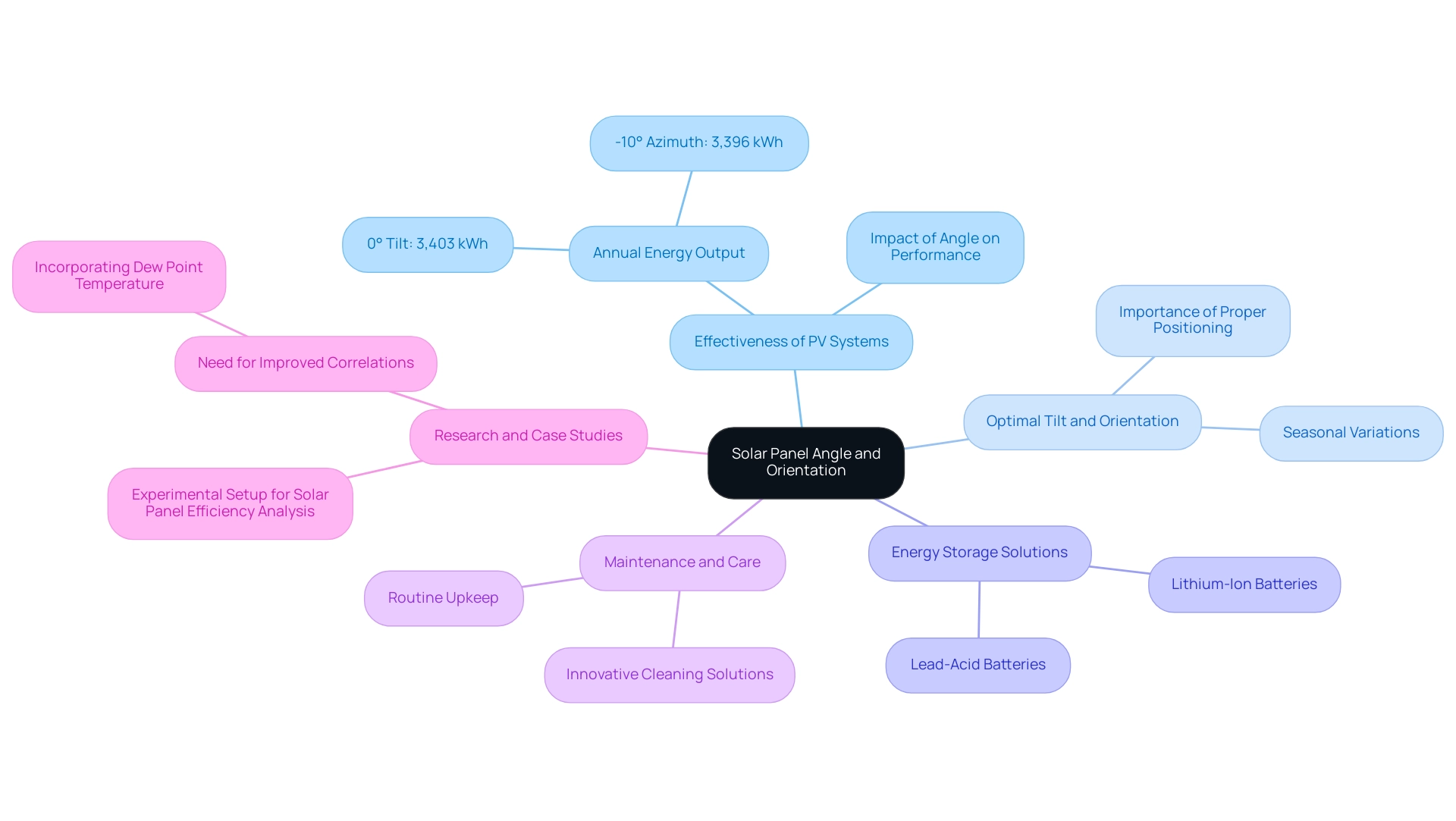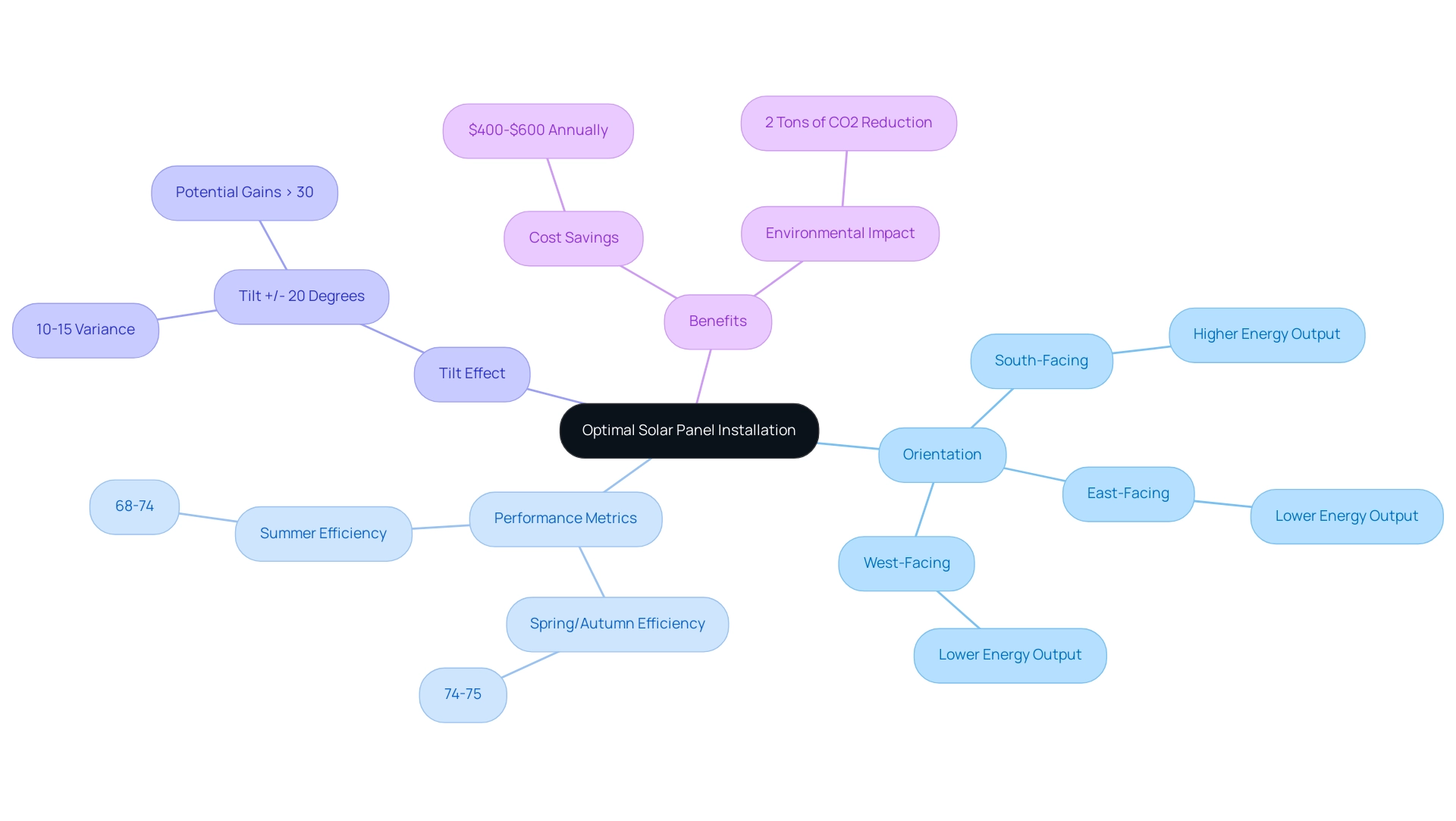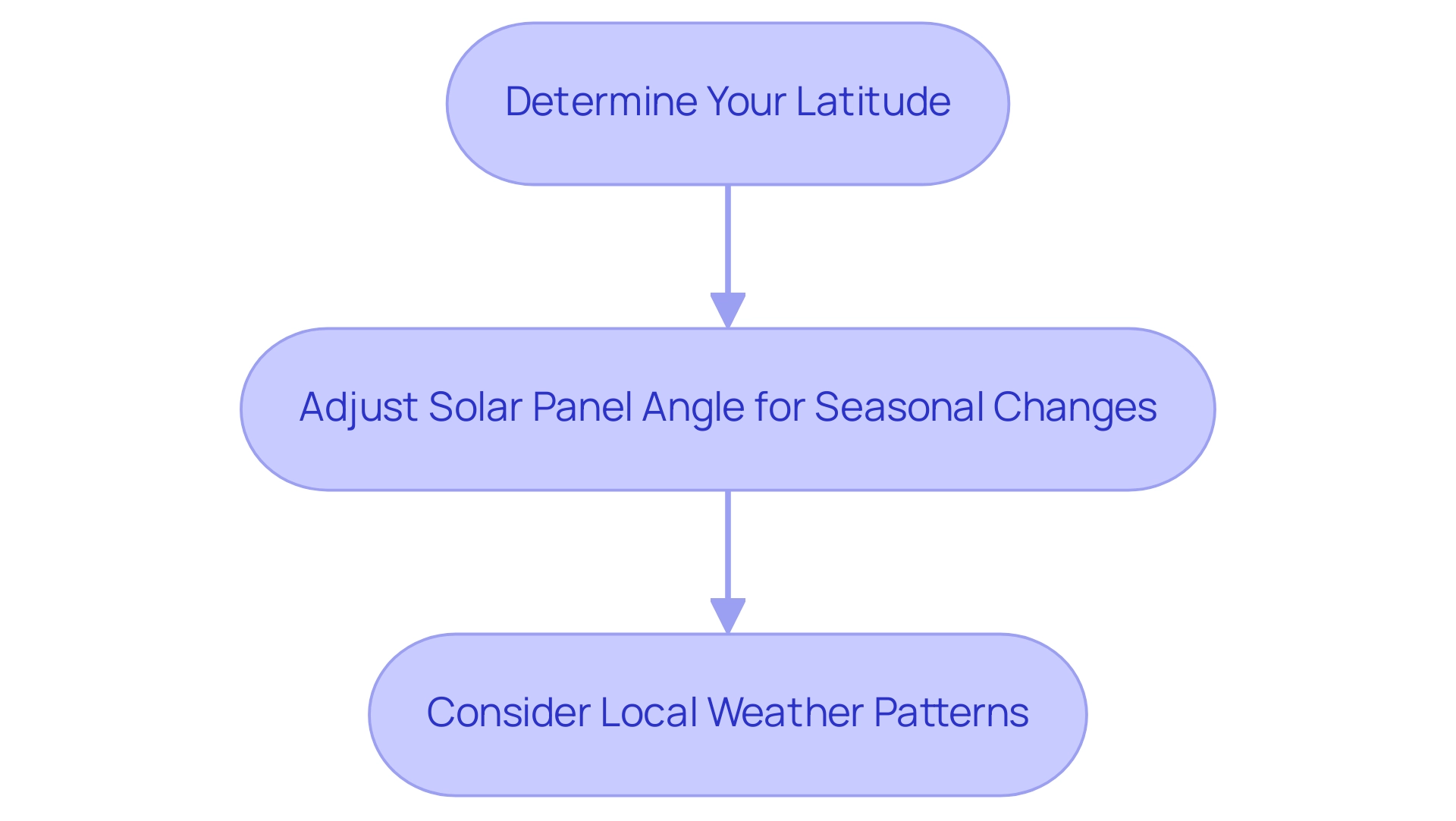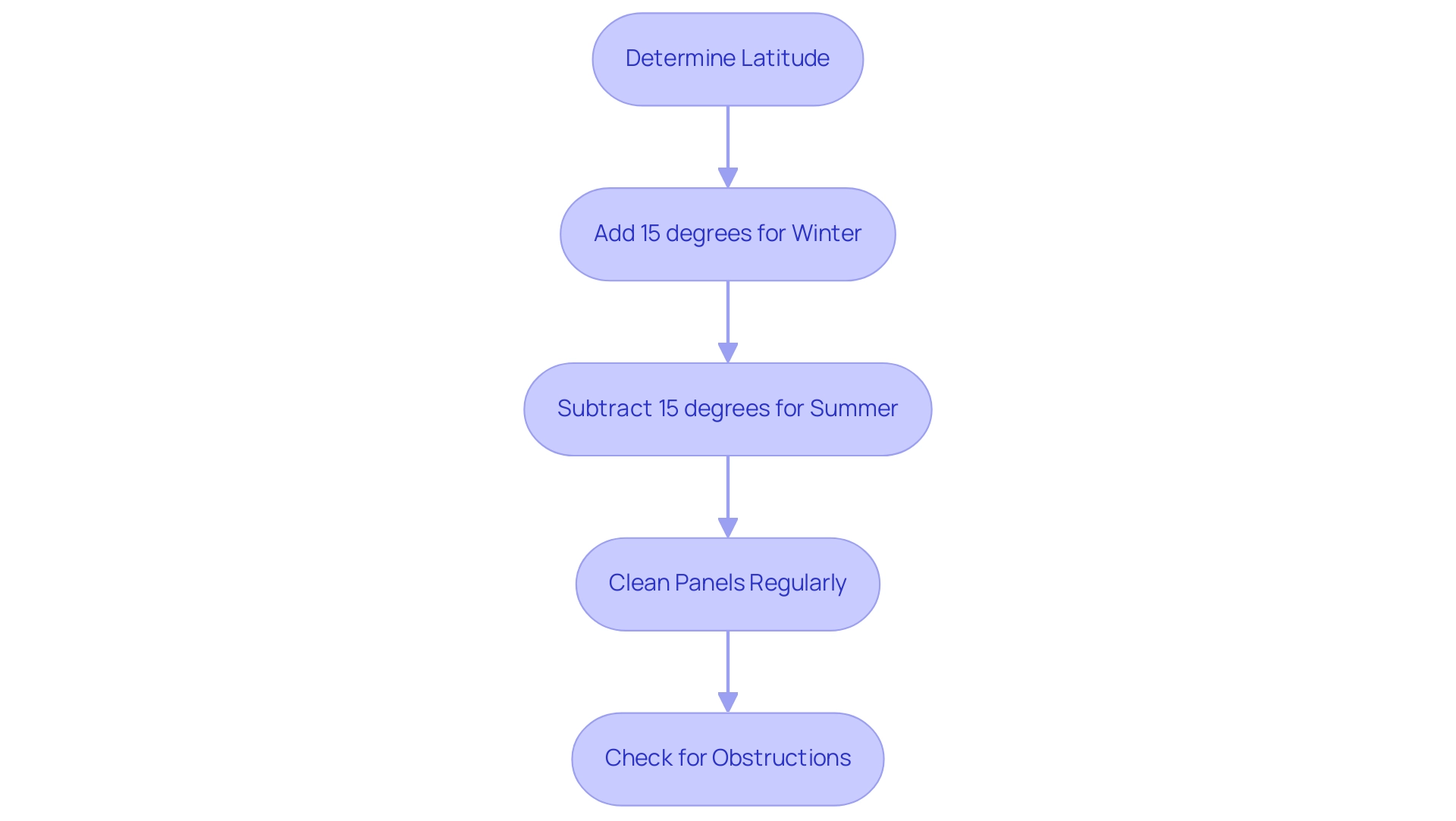Overview
The best solar panel angle by location is determined by factors such as geographic latitude, seasonal changes, and local climate conditions, which significantly influence sunlight capture and energy generation. The article emphasizes that adjusting the tilt angle according to these variables can enhance efficiency, with practical steps provided for homeowners to optimize their solar panel installations and maximize their investment in renewable energy.
Introduction
In a world increasingly focused on sustainability, solar energy stands out as a beacon of hope for homeowners seeking to reduce their carbon footprint and save on energy costs. However, the effectiveness of solar panels hinges significantly on their angle and orientation, which play a crucial role in maximizing sunlight capture.
This article delves into the intricacies of solar panel positioning, exploring how factors such as:
- Geographical location
- Seasonal changes
- Roof types
can influence energy production. From understanding the optimal tilt angles for different latitudes to the benefits of solar tracking systems, readers will gain valuable insights into enhancing their solar investments. Additionally, common installation mistakes will be highlighted, ensuring that homeowners can make informed decisions that lead to greater energy efficiency and financial savings.
As the demand for renewable energy solutions continues to grow, mastering the art of solar panel placement becomes essential for paving the way toward a sustainable future.
Understanding the Significance of Solar Panel Angle and Orientation
The effectiveness of photovoltaic systems in transforming sunlight into electricity is greatly affected by the solar panel angle by location and their orientation. Proper positioning of the units, including their tilt and directional orientation, is essential for maximizing sunlight capture throughout the day, and this is impacted by the solar panel angle by location. For maximum power generation, it is essential to place photovoltaic systems at the correct solar panel angle by location to improve sunlight exposure, which changes with the seasons and geographic area.
For instance, a PV system installed at a 0° tilt can generate an impressive annual output of 3,403 kWh at 90% projection rates, while a second optimum azimuth angle of -10° yields about 3,396 kWh annually, illustrating the importance of the solar panel angle by location for careful positioning. Furthermore, homeowners should think about effective energy storage alternatives, such as choosing the best batteries, which include options like lithium-ion batteries recognized for their longevity and performance, or lead-acid batteries that are more cost-effective but have a shorter lifespan. Routine upkeep is also essential to guarantee durability and performance, with innovative cleaning solutions accessible to assist in maintaining surfaces in optimal condition.
As highlighted in a case study titled ‘Experimental Setup for Panel Performance Analysis,’ evaluating panel effectiveness based on meteorological data is essential for optimizing performance. Ongoing research highlights the need to refine existing correlations predicting PV module efficiency by incorporating factors like dew point temperature. Ruchi Gautam asserts, > It’s crucial to power electric vehicles from sustainable sources, such as sunlight or wind power, if they’re to be genuinely durable <.
This emphasizes the significance of utilizing renewable resources effectively. By comprehending the dynamics of the solar panel angle by location and orientation, along with maintaining the systems and choosing optimal batteries, such as those suggested in the user manual ‘How Photovoltaic Panels Operate on a House,’ homeowners can significantly improve their investments for greater savings and performance, ultimately paving the way for a more sustainable future.
The Optimal Direction for Solar Panel Installation
In the Northern Hemisphere, the optimal solar panel angle by location is typically south-facing. This arrangement allows surfaces to capture the maximum amount of sunlight during the day, enhancing power generation. Research indicates that south-facing installations significantly surpass their east and west counterparts in terms of power generation.
Notably, while east and west-facing surfaces can still be productive, they generally yield lower energy output compared to those facing south. For example, information shows that in spring and autumn, sunlight collector performance ranges from 74-75%, while in summer, it varies from 68-74%. The thermal performance rating, which indicates how effectively a heater transforms sunlight into usable heat, is essential for evaluating overall performance.
Additionally, a series of tests have demonstrated that a tilt of plus or minus 20 degrees can lead to a 10 to 15% variance in output, with potential gains exceeding 30% when optimizing for battery storage, as highlighted in the case study titled ‘Testing Solar Panel Output at Various Angles.’ Homeowners are encouraged to evaluate their property layout, taking into account any surrounding structures that might obstruct sunlight. As the installation of power systems continues to trend upwards, particularly those equipped with intelligent tracking systems—which can increase radiation collection by at least 63.55%, and up to 122.51% compared to stationary panels—the importance of optimizing the solar panel angle by location becomes ever more critical.
By maximizing exposure to sunlight, homeowners not only enhance efficiency but also contribute to significant cost savings—estimated at $400 to $600 annually on utility expenses—and promote sustainability by reducing reliance on conventional power sources. Furthermore, the Environmental Protection Agency indicates that utilizing heating systems powered by sunlight can prevent 2 tons of carbon dioxide from entering the atmosphere each year, which is comparable to not operating a vehicle for four months. As environmentally aware selections become popular, understanding the solar panel angle by location is crucial for homeowners aiming to enhance their renewable power advantages.
Real-world examples, such as those found in the case study on how homeowners benefited from household energy systems under the 200% rule, further illustrate the financial and environmental advantages of adopting energy solutions.
How Location Influences Solar Panel Angle Requirements
Establishing the optimal solar panel angle by location for renewable energy systems is closely connected to geographical factors, making it crucial for environmentally aware homeowners to grasp this relationship. Research shows that as latitude increases, the optimal solar panel angle by location should become steeper to maximize sunlight capture during winter months. Conversely, regions closer to the equator benefit from a flatter installation.
Homeowners are encouraged to investigate their specific latitude and consider local climate conditions, as the solar panel angle by location may require adjustments in areas with frequent cloud cover to enhance power capture. Notably, significant energy gains can be realized throughout various times of the day. An expert perspective indicates that targeting the midday sun may not produce the highest cumulative totals, highlighting the necessity for strategic planning in installation.
Furthermore, installing photovoltaic systems on walls can be less efficient due to shading and stability concerns, which should be considered during planning. Comprehensive research from Stanford University provides equations for calculating the solar panel angle by location, which are applicable in both the Northern and Southern hemispheres, affirming that these adjustments can yield an increase in annual power output of 7–8%. Their experimental arrangement, which included five photovoltaic units, each rated at 1 kW, supports assertions about power output and performance.
Additionally, regression analysis of real-time data shows that the solar panel angle by location influences optimal tilt angles, which decline from January to August and rise from September to December, highlighting how geographical location impacts the performance of photovoltaic systems over time. To calculate the optimal solar panel angle by location, homeowners can follow these steps:
- Determine your latitude;
- Adjust the solar panel angle by location based on seasonal changes;
- Consider local weather patterns.
Ultimately, understanding the influence of solar panel angle by location on photovoltaic system performance is vital for maximizing power production and reducing CO2 emissions, estimated to be between 27.55 kg to 32.8 kg annually with optimal angle configurations.
This knowledge enables homeowners to make informed choices that improve both their efficiency and environmental sustainability. For additional insights, homeowners may also investigate related articles on photovoltaic system upkeep and government initiatives that promote renewable resources adoption.
Calculating the Best Tilt Angle for Maximum Solar Efficiency
Determining the ideal solar panel angle by location for photovoltaic systems is crucial for maximizing energy generation throughout the year. A commonly used formula suggests adjusting the solar panel angle by location based on latitude: add 15 degrees for winter and subtract 15 degrees for summer. For instance, at a latitude of 35 degrees, the ideal solar panel angle by location would be 50 degrees for winter and 20 degrees for summer.
This seasonal adjustment is essential, as it enables homeowners to adjust the solar panel angle by location to align their solar systems with the sun’s changing position, thereby enhancing efficiency. Research indicates that properly positioned panels can reduce CO2 emissions by an estimated 27.55 kg to 32.8 kg annually, contributing positively to the environment. Comprehending the significance of optimal battery selections is vital for efficient power storage in residential setups.
Recent studies have established empirical models for estimating the solar panel angle by location using data from meteorological stations in Libya, enhancing the reliability of these calculations compared to satellite data. A case study titled ‘Statistical Validation of Tilt Angle Models’ employed statistical validation techniques, confirming that these models provide reliable estimates for the solar panel angle by location and supporting their practical applications in photovoltaic system design. Specialists in photovoltaic energy promote these modifications, claiming that practical uses of adjusting the solar panel angle by location greatly enhance energy performance.
Furthermore, homeowners are urged to adhere to user manual instructions for routine upkeep of their energy systems, which is essential for guaranteeing sustained efficiency and performance. This includes:
- Cleaning panels regularly
- Checking for any obstructions that may block sunlight
Moreover, examining government initiatives and nearby cleaning services can provide extra assistance in enhancing power systems.
By adopting these practices, homeowners not only enhance their energy output but also encourage sustainable living, contributing to long-term sustainability and the economic and environmental advantages of heating systems.
Practical Considerations for Solar Panel Installation: Roof Type and Shading
When contemplating the installation of photovoltaic modules, it is essential to assess both the kind of roof and possible shading from nearby trees, buildings, or other structures. Different roof configurations—such as flat, sloped, or tiled—demand specific mounting systems to optimize performance. Significantly, typical average photovoltaic system performance is around 20% for residential setups, offering homeowners a clear standard for their expectations.
Research indicates that south-facing energy collectors, while common, are often the least efficient in Australia, as emphasized by Isaac Jamieson, founder and director of Tenmen Electrical, who states, ‘South-facing collectors are the least efficient in Australia.’ Moreover, shading can considerably obstruct power generation; it has been noted that exposure to sunlight can reduce photovoltaic efficiency by 1-3% within the first 1,000 hours due to boron oxide formation.
To optimize output, homeowners should thoroughly evaluate how shadows move across their roofs during the day. A study examining 70 case studies on photovoltaic installations emphasizes the essential requirement for homeowners to choose sites that reduce shading and improve the solar panel angle by location to enhance sunlight exposure. Moreover, choosing the appropriate battery is crucial for effective power storage, allowing homeowners to use their produced power efficiently.
Routine upkeep and creative cleaning methods, like utilizing a soft brush or a squeegee with a mild cleaning solution, also play a crucial part in maintaining performance and durability, ensuring that photovoltaic systems function at their best. Furthermore, the results from the ‘Holistic Analysis of Roof Albedo Effects’ highlight the importance of thorough data in the PV sector, suggesting parametric relationships to enhance roof albedo for maximizing power performance and lowering expenses in PV installations. By understanding how roof type and shading affect photovoltaic system efficiency, along with the significance of battery choice and upkeep, homeowners can make informed decisions that boost power generation and lower expenses.
For comprehensive guidance on installation and troubleshooting, homeowners are urged to refer to the user manuals that come with their energy systems.
Enhancing Solar Efficiency with Tracking Systems and Adjustable Mounts
Tracking systems are designed to dynamically modify the solar panel angle by location throughout the day, aligning them with the sun’s path to enhance power absorption. By employing these systems, homeowners can achieve an impressive increase in energy production, with estimates ranging from 25% to 35% compared to traditional fixed installations. This enhancement not only boosts performance but also leads to substantial cost reductions on utility bills, supporting the economic justification for investing in renewable technologies.
For instance, solar water heating systems can save homeowners between $400 to $600 each year on utility expenses. The versatility of adjustable mounts further enhances this efficiency, allowing homeowners to modify the solar panel angle by location according to seasonal changes, thus maximizing performance year-round. Although the initial investment may be higher, the long-term benefits in energy savings and reduced reliance on traditional electricity sources often outweigh these costs.
Recent advancements in sunlight tracking technology, paired with the easing of supply chain disruptions, have made these systems more accessible and cost-effective. As the global market for trackers is projected to grow significantly—expanding from $8.9 billion in 2022 to $16.0 billion by 2031—more than half of utility-scale photovoltaic systems in the U.S. are now utilizing tracking technology. This trend underscores the increasing recognition of the importance of adaptive solutions in the renewable energy sector, promoting job creation and equitable access to sustainable energy.
Additionally, sunlight heating systems can prevent 2 tons of carbon dioxide from entering the atmosphere each year, which is comparable to not operating a vehicle for four months. However, it’s important to note that semi-continuous tracking-based PV systems can exhibit a decrease of 1.12% in power output, highlighting that while tracking systems offer significant benefits, they are not without their challenges. As mentioned by Next Business Media, the Energy Evolution Awards, Conference, and Expo will act as a platform for fostering innovation and shaping a brighter, more efficient landscape, further highlighting the crucial role of progress in photovoltaic technology.
Common Mistakes to Avoid in Solar Panel Installation
When setting up solar systems, several typical errors can reduce efficiency and obstruct savings. One critical error is neglecting to consider shading, as even partial shade can significantly reduce performance of the system. Equally important is the optimization of the solar panel angle by location and orientation; incorrectly placed units can lead to suboptimal power capture.
Homeowners should also be aware of government programs and local regulations that could enhance financial returns and facilitate access to eco-friendly power solutions, especially advantageous for Long Beach renters considering renewable alternatives. For example, initiatives such as the California Solar Initiative offer financial rewards to homeowners who set up photovoltaic systems, facilitating access to renewable power.
With fossil fuel electricity costs projected to rise by 2.2% annually, investing in photovoltaic solutions appears as a budget-friendly option. Research indicates that over 40% of installers express dissatisfaction with their photovoltaic (PV) system performance, underscoring the need for meticulous planning and understanding of photovoltaic technology in homes. Additionally, substandard equipment can significantly affect output capacity, making it crucial to choose high-quality modules with appropriate output ratings for maximizing performance and ensuring a sufficient power supply.
Furthermore, expert installation is vital for the success of renewable systems. Surveys reveal that many installers overlook the necessity of regular cleaning, crucial for maintaining performance. Creative cleaning methods, like utilizing a gentle brush with a biodegradable detergent or using automated cleaning robots, can greatly improve surface cleanliness and effectiveness.
A case study highlights this point, demonstrating a direct relationship between panel cleanliness and performance, with suggestions for cleaning every six months to maintain both efficiency and revenue.
As Andrey Gorichenski, Senior Editor, states, ‘Climate change and its impact on people’s lives has always been among my interests…’ This viewpoint stresses the urgency of adopting renewable solutions. In essence, avoiding pitfalls such as improper shading considerations, neglecting the solar panel angle by location optimization, and choosing inferior materials can lead to enhanced performance and long-term financial benefits. Thorough research and professional assistance are indispensable for achieving optimal results in solar energy installations.
Conclusion
Understanding the intricate dynamics of solar panel angle and orientation is vital for homeowners aiming to maximize their energy production and embrace sustainability. The article highlights that optimal positioning—considering geographical location, seasonal changes, and roof types—can significantly enhance the efficiency of solar systems. By implementing the right tilt angles and orientations, homeowners can capture more sunlight, reduce carbon emissions, and ultimately save on energy costs.
Moreover, the importance of avoiding common installation mistakes cannot be overstated. Factors such as:
- Shading
- Improper angle adjustment
- The use of low-quality equipment
can severely hinder performance. With the rising demand for renewable energy solutions, it is essential for homeowners to make informed decisions, select high-quality materials, and consider professional installation to ensure their solar systems operate at peak efficiency.
As the world moves towards more sustainable energy practices, mastering the art of solar panel placement becomes a critical component of successful energy management. By understanding and applying the principles discussed in this article, homeowners can not only enhance their solar investments but also contribute to a more sustainable future, paving the way for a cleaner, greener planet.


